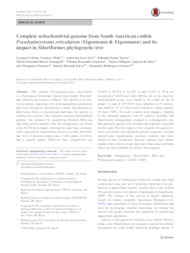Complete mitochondrial genome from South American catfish Pseudoplatystoma reticulatum (Eigenmann & Eigenmann) and its impact in Siluriformes phylogenetic tree.
Complete mitochondrial genome from South American catfish Pseudoplatystoma reticulatum (Eigenmann & Eigenmann) and its impact in Siluriformes phylogenetic tree.
Author(s): VILLELA, L. C. V.; ALVES, A. L.; VARELA, E. S.; YAMAGISHI, M. E. B.; GIACHETTO, P. F.; SILVA, N. M. A. da; PONZETTO, J. M.; PAIVA, S. R.; CAETANO, A. R.
Summary: The cachara (Pseudoplatystoma reticulatum) is a Neotropical freshwater catfish from family Pimelodidae (Siluriformes) native to Brazil. The species is of relative economic importance for local aquaculture production and basic biological information is under development to help boost efforts to domesticate and raise the species in commercial systems. The complete cachara mitochondrial genome was obtained by assembling Illumina RNA-seq data from pooled samples. The full mitogenome was found to be 16,576 bp in length, showing the same basic structure, order, and genetic organization observed in other Pimelodidae, with 13 protein-coding genes, 2 rNA genes, 22 trNAs, and a control region. Observed base composition was 24.63% T, 28.47% C, 31.45% A, and 15.44% G. With the exception of NAD6 and eight tRNAs, all of the observed mitochondrial genes were found to be coded on the H strand. A total of 107 SNPs were identified in P. reticulatum mtDNA, 67 of which were located in coding regions. Of these SNPs, 10 result in amino acid changes. Analysis of the obtained sequence with 94 publicly available full Siluriformes mitogenomes resulted in a phylogenetic tree that generally agreed with available phylogenetic proposals for the order. The first report of the complete Pseudoplatystoma reticulatum mitochondrial genome sequence revealed general gene organization, structure, content, and order similar to most vertebrates. Specific sequence and content features were observed and may have functional attributes which are now available for further investigation.
Publication year: 2017
Types of publication: Journal article
Observation
Some of Embrapa's publications are published as ePub files. To read them, use or download one of the following free software options to your computer or mobile device. Android: Google Play Books; IOS: iBooks; Windows and Linux: Calibre.
Access other publications
Access the Agricultural Research Database (BDPA) to consult Embrapa's full library collection and records.
Visit Embrapa Bookstore to purchase books and other publications sold by Embrapa.

